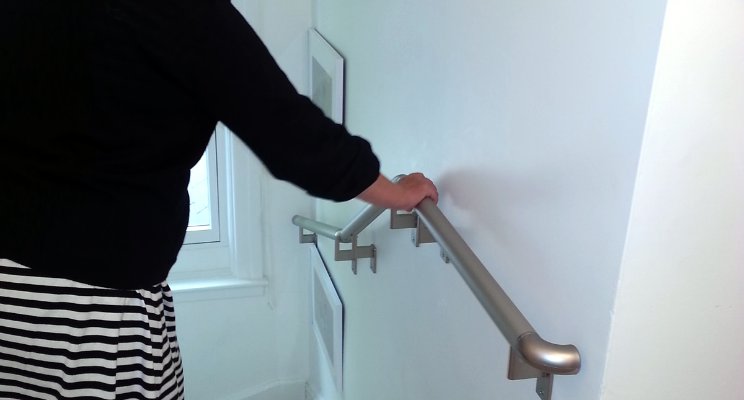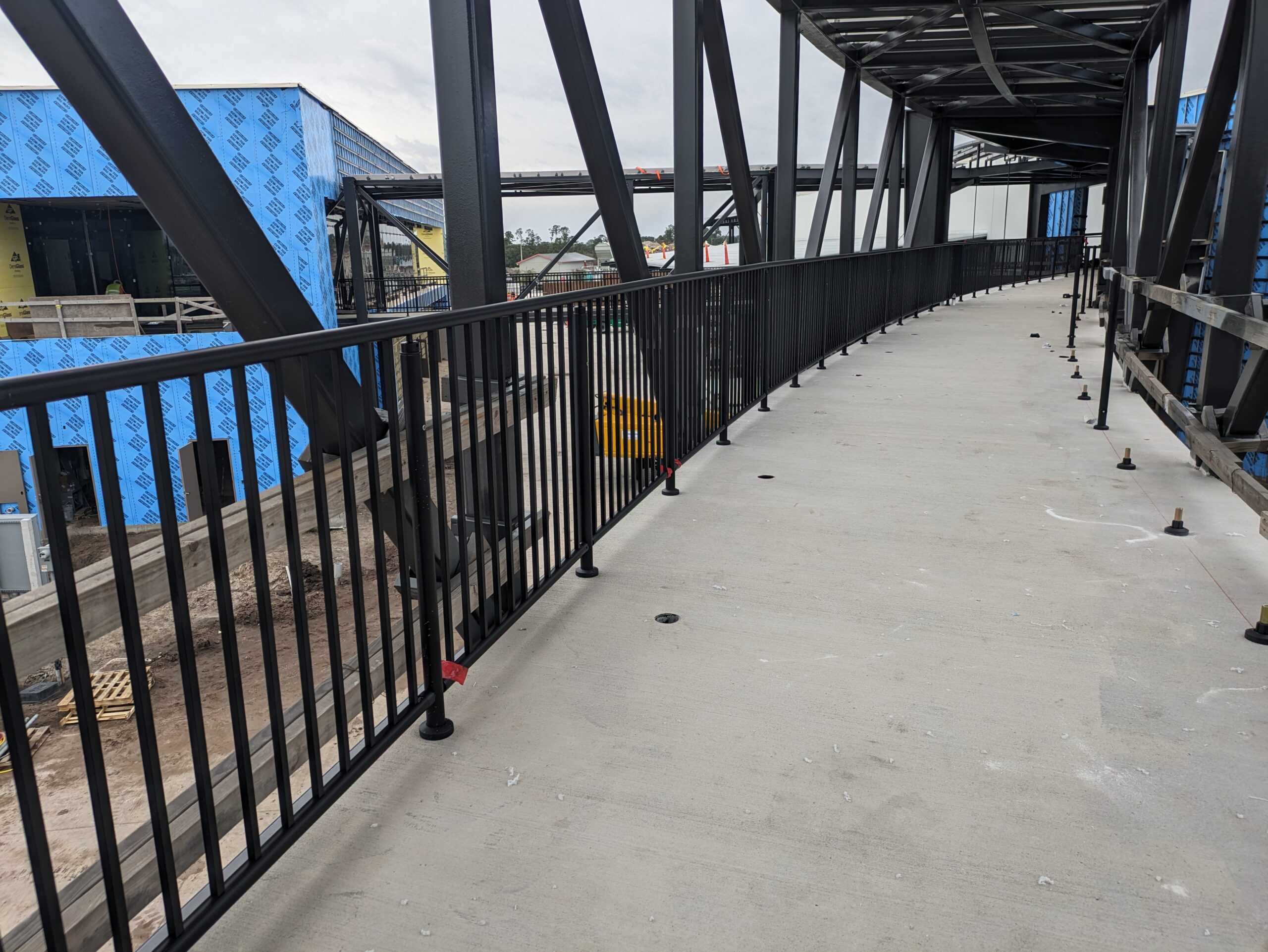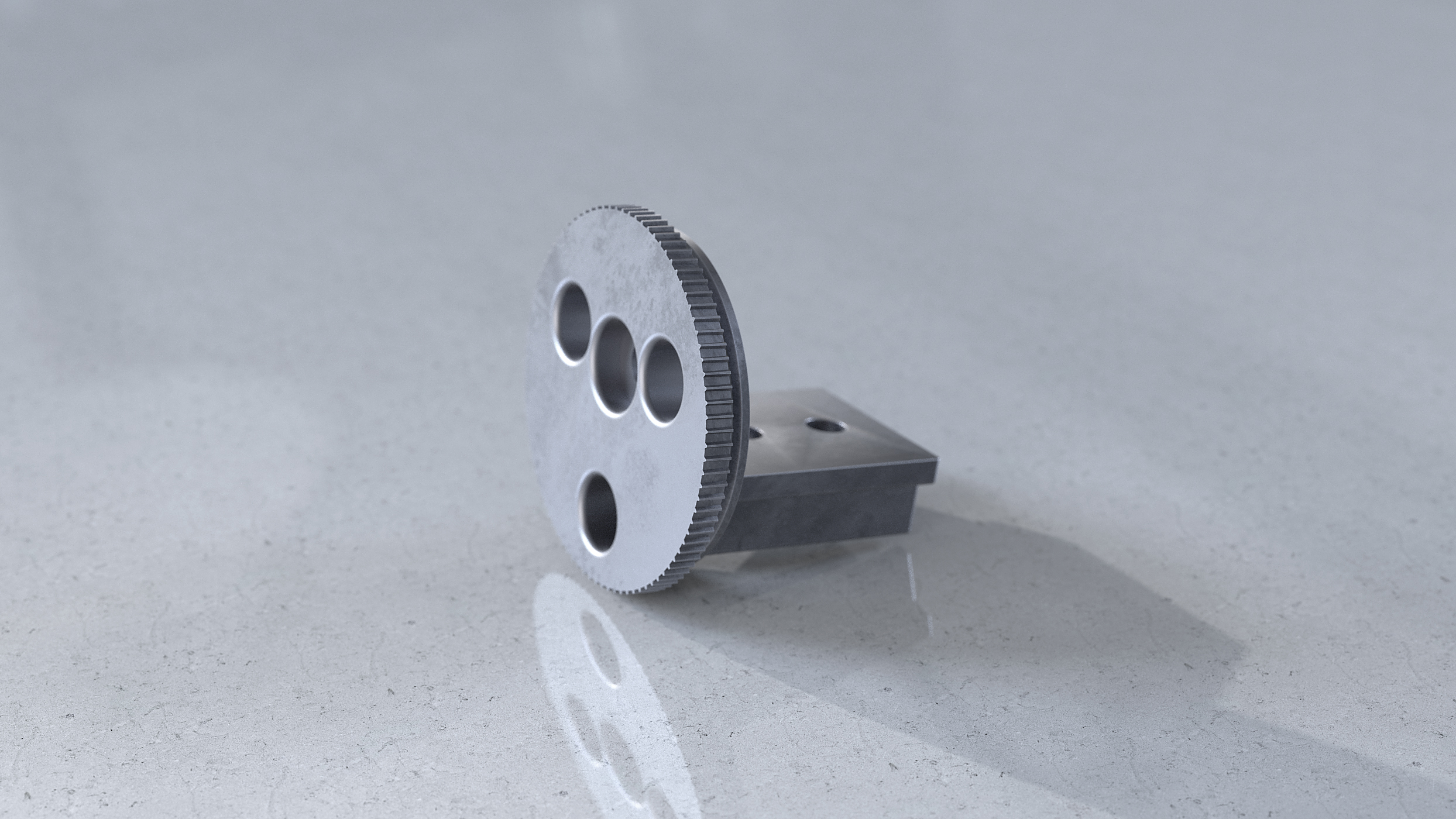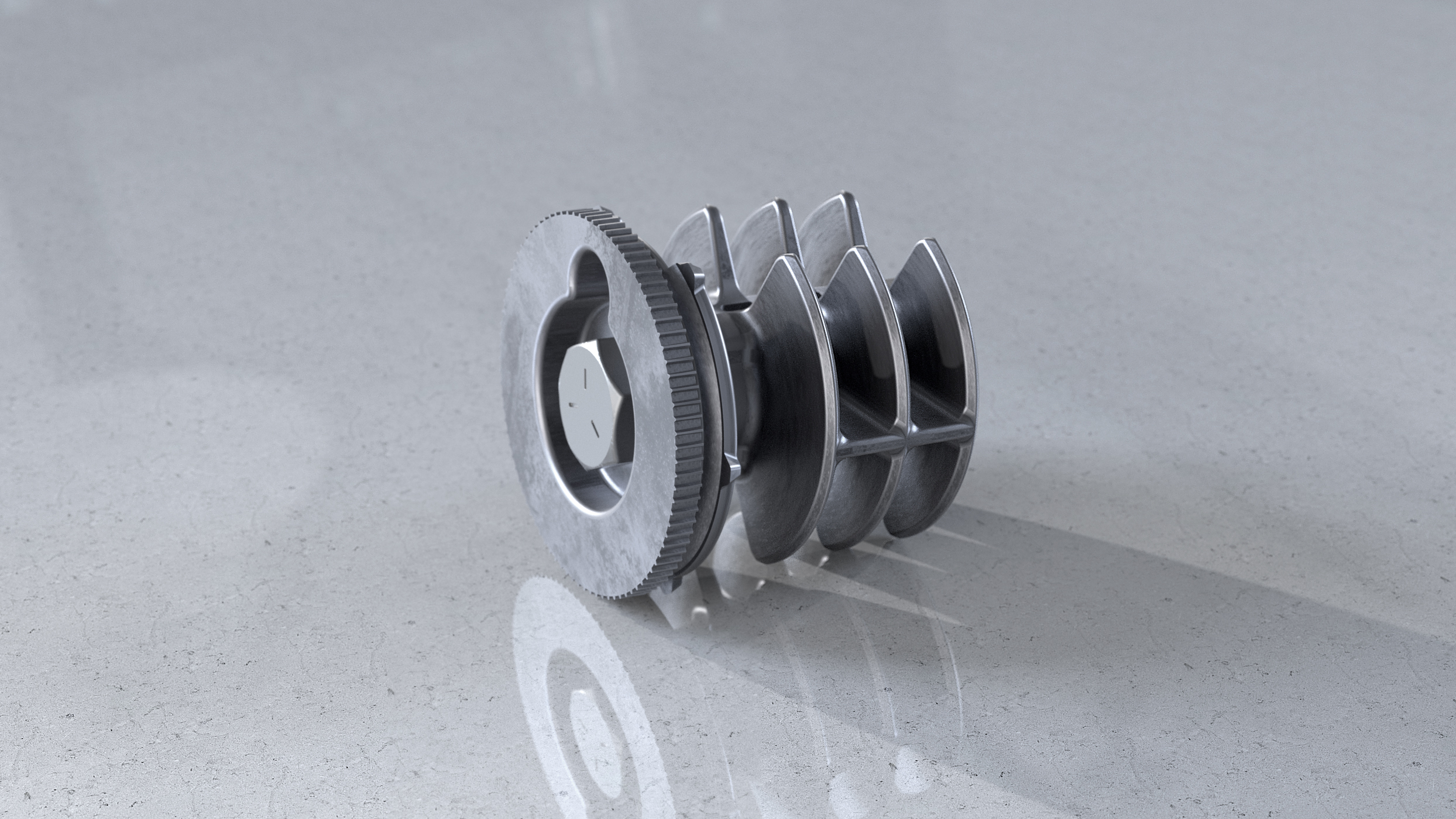Handrails and stair railings – they sound like pretty much the same thing, right? They’re not.
While stair railings are simply railings on stairs, a Promenaid handrail meets Americans with Disabilities Act (ADA) standards, as well as the most stringent safety and stability demands. In addition, our handrails are designed to exceed building code requirements – simply, easily and attractively. That’s why professional builders and DIYers are installing Promenaid handrails in houses, apartments and public spaces of all kinds. You can find our sleek handrailings installed in spaces from offices and movie theatres to churches and hospitals. Want a closer look? Check out our customer photo gallery and get inspired by the unique combinations and stylistic choices that our customers have made with our handrails.
Our dedication to safety, accessibility and design is why people are choosing Promenaid handrails to protect family members, such as seniors and those with decreased mobility, from the threat of falling. Rock solid and designed to be elegant safety features in any stairwell, Promenaid handrails are made to be easy to install and are the ideal solution for mobility challenges.
A stair railing, on the other hand, is primarily used to prevent people from falling off the side of the stairs. They aren’t asked to do much more – and they usually don’t.
The Grip
Grip is a key difference between Promenaid handrails and stair railings. Our handrails enable users to get the firm grip they need for stability and security. Stair railings don’t.
Picture a standard household stair railing. It’s somewhat rectangular-shaped with a slight bulge at the top, like a loaf of bread. You can run your hand along its surface as you climb the stairs, but can you really grab it and get a solid grip when you need to? Unfortunately, the answer is often no.
A huge difference between Promenaid handrails and the average stair railing is the ability to get a power grip. To get a power grip, you must be able to wrap your fingers around the railing fully. The power grip is five times stronger than the pinch grip on a typical stair railing. Consequently, the ADA requires handrails, like those offered by Promenaid, to be between 1-½ and 2 inches in diameter, because anything less means a higher risk of falling.
Think of it this way: Imagine trying to swing a hammer by holding it with your fingertips. This flimsy grip is similar to how many people would grip a decorative stair railing. Your chances of losing grip on the hammer while holding it in your fingertips are far higher than if you were to grip the hammer’s handle tightly in your hand. The same holds true if you should lose your balance as you walk up or down a flight of stairs. When your hand doesn’t have a secure hold, you’re at a greater risk of losing your grip and taking a fall.
Wrapping your hand entirely around the railing is what we mean when we use the term “power grip,” and studies demonstrate that it is five times stronger than a “pinch grip.”
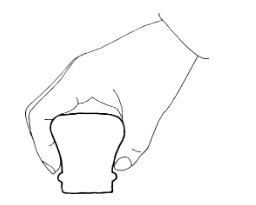
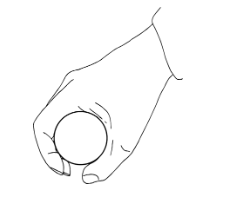
Continuous Contact
A Promenaid ADA-compliant handrail provides continuous, uninterrupted support compared to traditional stair railings that are often broken up by posts or gaps at the corners. A Promenaid handrail follows every angle and outline of a staircase, so you never have to take your hand off the handrail at any point during your climb. That means more points of contact with the handrail and more security to stay upright and stable.
The right handrail bracket is key to continuous handrail contact. A safe bracket can’t get in the way of hand movement along the railing. Our “L”-shaped brackets connecting at the handrail’s bottom do that job best, which is why Promenaid uses them. These brackets make it easy to hold the handrail with a power grip at all times for maximum safety.
Strength
Strength is a true test of a handrail or a stair railing’s quality. You want it to withstand a sudden pull when you grab harder to prevent a sudden fall – not come out of the wall. Promenaid handrails are made from extruded aluminum with rib reinforcements that deliver extraordinary lightweight strength.
Our die-cast zinc brackets with rounded corners are strong enough to withstand 500 pounds of force in any direction – exceeding the AC273 requirements of the International Code Council. In addition, our handrails are manufactured in North America from 100% sustainable materials. With our handrail manufacturing experience dating back over 40 years, you can ensure you’re purchasing a high-quality handrail when you purchase one from Promenaid.
Adding a Secondary Handrail
Many decks, ramps and elevated porches have decorative railings. The railings on these residential and public spaces must be 42 inches high to prevent falls over the side. Unfortunately, these railings are not always meant to be handrails, meaning they may not be built to provide the safety and stability of a Promenaid handrail.
Installing a secondary Promenaid handrail at 36 inches high can deliver ADA compliance without the expense and hassle of removing the existing railing. In addition, our sleek designs pair seamlessly with many existing decorating schemes. You might choose our revolutionary TrueWood™ handrails for an existing wood deck, or one of our Endura™ anodized aluminum satin-finished handrails for a stylish modern look.
Attractive and Durable Finishes
Promenaid handrails’ good looks matched with the security of meeting code requirements is a powerful combination for architects, professional builders and DIYers. Our handrail kits make ADA compliance a breeze and simplify the process of ensuring that your build meets the residential Code for Handrails.
Promenaid handrails, with beautiful finishes that work in any setting, are the increasingly popular choice of designers. You can choose from satin black, champagne silver or architectural bronze satin anodized aluminum handrails. The anodizing process gives the aluminum a beautiful look with unmatched durability. In addition, the finishes are scratch and weather resistant, making them perfect for interior and exterior uses without risk of the painted finishes chipping, flaking or fading.
Promenaid TrueWood™ is an ideal way to add a warm, natural wood look to an interior handrail. These finishes don’t just look like real wood; they are real wood. A very thin layer of wood is bonded to the aluminum core to bring the natural appeal you want to the strength and durability you need. In line with Promenaid’s commitment to sustainability, these handrails require 50 times less wood than solid wood handrails. Our TrueWood™ handrails are available in prefinished black walnut and red oak. For a custom appearance, you can choose an unfinished oak handrail and stain it in the color of your choice.
Promenaid handrail brackets, fittings and endcaps are available in matte nickel, antique brass and satin black finishes.




Promenaid – More Than Just a Handrail
Builders and designers are putting Promenaid handrails to work in diverse applications far beyond just staircases. In both family homes and public settings, they are installing them along hallways, corridors and wherever people need support and stability to help prevent falls. DIY and professional customers alike are also turning to Promenaid for easy-to-install handrail kits to make short runs of stairs safer – whether it’s one step to a sunken living room or several steps from a garage into the home – thanks to a simple 18-inch, 24-inch or 36-inch handrail kit.
Customers also switch to Promenaid Integra™ grab bars for shower, bathtub and toilet area applications. Our grab bars have the strength, versatility and elegance of Promenaid handrails, but can be used around doorways without the unsightly flanges of traditional grab bars for a far sleeker and cleaner look. In addition, the non-slip, anti-bacterial vinyl inserts provide added grip where people need it most.
Outdoor Handrails
Promenaid ADA-compliant handrails deliver simple, attractive and easy-to-install results in outdoor situations as well, both along walls and attached to posts. A continuous handrail is an easy way to minimize the health and legal risks of spills and falls along residential or commercial building footpaths and near doorways, especially for anyone carrying items like groceries.
DIY Handrail Kits
Promenaid customers love how our DIY handrail kits make it simple to add code-compliant handrails to their homes or commercial, institutional and industrial buildings. Complete Promenaid handrail kits from 18 inches to 18 feet are available on Amazon.com.
Choosing the right kit takes just a few simple steps:
- Choose your handrail and hardware finishes.
- Choose the endcap and bracket styles.
- Choose the length – to the inch.
Our 90-degree endcaps are also known as “ADA returns” or “wall returns” because they comply with the code by returning the handrail to the wall. With these wall returns, nothing gets snagged or caught by the handrail.
We include the correct number of brackets for the length ordered in each kit. Our patented bracket locks in place anywhere along the handrail, so it’s easy to attach them wherever a stud is in a wall. These brackets enable even a DIY builder to angle them to match the grade of any staircase.
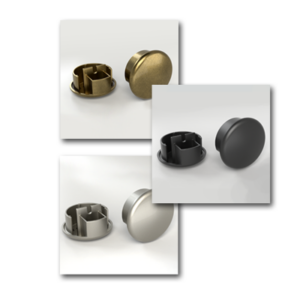
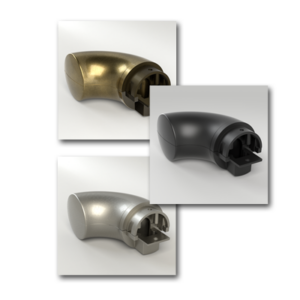
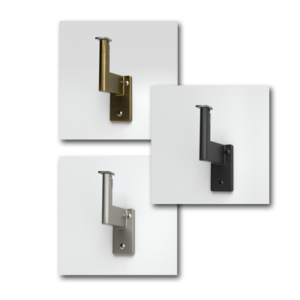
Custom Handrails
A custom order from Promenaid is the easiest way to get a handrail for a more complex configuration than our pre-built kits. Customization enables a solution that is just right for corners, slope changes, different angles and specific lengths. In addition, a custom order is a perfect choice to ensure your handrail installation complies with local building requirements and with the ADA code.
Use our helpful online guides to learn more about calculating handrail lengths, stair pitch or grade. You can also search for a dealer near you to see our handrails in action. Then, with a clear plan and measurements, Promenaid creates and ships your made-to-measure handrail in as little as 24 hours, thanks to our modular design.
Our handrails’ unique articulating joints make it easy to navigate any corner or change in slope without complicated calculations or compound miter cuts. The installation is simple and easy – even when some trimming is required to ensure the most precise fit around corners and on slope changes. Our aluminum handrails are designed to be easily cut to the required length with a standard miter saw equipped with a carbide blade. There’s no sanding or deburring required.
Americans with Disabilities Act Requirements for Handrails
The ADA guidelines are widely accepted as an international benchmark for accessibility. In addition, they are reflected in codes such as the International Building Code commercial standard for handrails and the International Residential Code. When properly installed, Promenaid handrails proudly meet all these requirements.
ADA guideline handrail standards include the following statutes:
- Handrails must be present on both sides of stairs and ramps.
- Handrails must be continuous for the full length of each flight of stairs or ramp, including along switchback or dogleg configurations.
- The top surface of the handrail must be between 34 and 38 inches above the walking surface. (Note: In areas where children are the principal users, a second handrail can be installed at an appropriate height.)
- The handrail’s gripping surface must have a minimum of 1-½ inches of clearance from adjacent surfaces (wall or posts).
- The handrail’s gripping surface must also be unobstructed on its top and sides with a minimum clearance of 1-½ inches from horizontal projections below, such as those on supporting brackets.
- The circular handrail must be 1-¼ to 2 inches in diameter. (Non-circular handrails must have a surface perimeter within the same range.)
- The gripping and adjacent surfaces must not have any abrasive or sharp elements, and edges must be rounded.
- The handrail must not rotate in its fittings.
- The handrail must extend horizontally by at least 12 inches at the top of any stair flight or ramp run and must return to the wall, guard or landing surface. (Note: extensions are not required for continuous handrails in a dogleg or switchback.)
Visit the United States Access Board website for more information about the ADA standards and to learn about all considerations and exceptions that may affect your project.
Find out more about handrail installation, handrail kits and custom handrails by contacting Promenaid Handrails at 888-992-4943.



